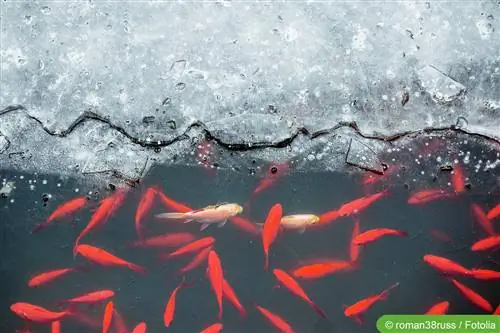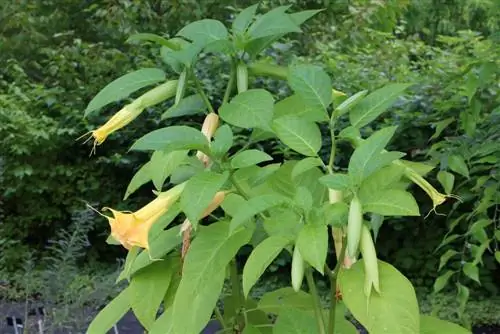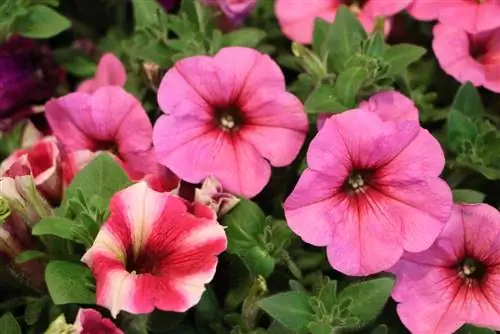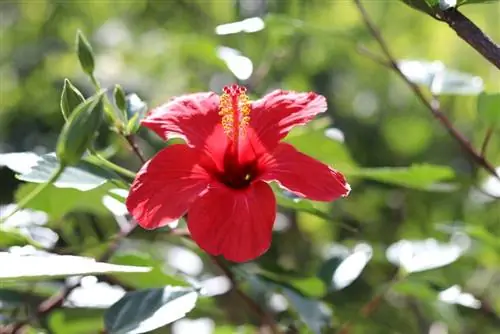- Author admin [email protected].
- Public 2023-12-17 03:39.
- Last modified 2025-06-01 06:48.
When winter slowly creeps up, goldfish owners have to think about how the animals will overwinter. It depends on the pond whether the goldfish can stay in their natural home over the winter or not.
When can goldfish spend the winter outside in the pond?
- The depth of the pond plays a crucial role. Only if the pond is more than 80 cm deep is the temperature in the lower water area around 4 °C, which is vital for the fish.
- The goldfish should live in the pond for at least six months, because then they are adapted to their surroundings and the prevailing environment.
- The fish need enough oxygen even in winter. An aerator stone can be used to ensure that bad gases are removed from the pond and oxygen is introduced into the water.
- In addition, an aerator stone ensures that a spot on the water surface remains ice-free, one of the most important points when overwintering goldfish.
Preparing for winter
So that all goldfish survive the winter unscathed, the first measures will begin in late autumn:
- The pond owner goes into the pond and removes all leaves and dead plant remains.
- Aquatic plants are cut back heavily.
- Next, attention should be paid to bottom mud.
- If too much has accumulated, some of it should be vacuumed out.
- If you don't have a special device, you can borrow one from most pond or fish shops.
- The ice preventer or aerator stone is installed before the first frost threatens.
- All accessories such as circulation pumps, filter media or fountains are switched off, because the constant mixing of the water would cause the temperature to drop even further.
- From a water temperature of around 8 °C, the animals are no longer fed, because the goldfish's metabolism works on a low level.
The reason for removing the plant remains is quickly explained: decaying plant remains consume the oxygen that is important for the goldfish. They also release CO2 themselves, which can ultimately lead to suffocation of the fish.
General information about feeding goldfish
Whether goldfish need to be fed at all depends largely on the size of the pond. In a proper biotope, feeding can be completely dispensed with. In a smaller pond, however, additional feeding is required. The water quality is then regularly examined in the summer months, as sinking feed can lead to poorer quality. Goldfish are omnivores, so you should be guided by variety when choosing food.
When winter has arrived
When all preparations are complete, winter can come. But even after his arrival, the focus must be on the welfare of the animals. For example, if snow falls on the pond, it should be carefully removed before thawing. Of course, during this process as little snow as possible should fall through the ice-free area directly into the pond. In addition, the goldfish owner must cause as little unrest as possible so that the animals do not suffer from the stress. Otherwise, you should take a look at the pond every day to check the welfare of the animals. If a warm period occurs in winter, the fish restart their metabolism. In these cases, some sinking food should be used to prevent the animals from getting too far up, because the surface is still colder than the water at the bottom of the pond.
Sick fish - what to do?
A sick fish shows clear symptoms:
- It swims or floats quite high up.
- Occasionally he lies on his side.
Of course you should try to help the animal. The goldfish is taken out of the water with the landing net and placed in a tub that consists of pond and tap water in a ratio of 1:1. The sick animal is now slowly warmed over a period of two days to bring it to the temperature where it can fully survive the winter. In this environment he can receive his medication and hopefully recover.
Overwintering goldfish in the house
If the pond does not have the necessary depth, the animals have to move to a cold water pool before the first frost. A water temperature of around 8 °C serves as an approximate guideline. The best place for the goldfish would of course be a cold but frost-free room, such as the garage or basement. The container should be equipped with a pump and filters and the bottom should be covered with sand. A mixture of pond and tap water makes the most sense. This means that the fish do not completely lose their connection to “their” water and they get used to it more quickly. Feeding begins slowly in the spring. This process takes up to several weeks. After about one to two months you will be back to the normal amount of food. Only when there is no longer any threat of frost will the animals be put back into the pond.
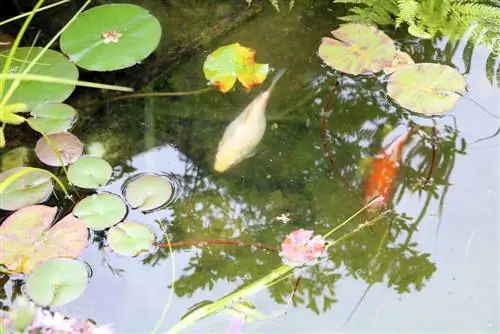
Goldfish are becoming increasingly popular among pond owners. However, they are living animals with needs that should be taken into account. If the animals have to move into the house in winter, the demands on the cold water pool are high. Too many animals in a tank that is too small is not possible. The fish need enough space, even if they fall into a kind of hibernation state. If necessary, several such pools have to be set up. The fish thank you with he alth and joy of life.
What you should know about overwintering goldfish in brief
Wintering in the pond
To decide whether it is possible to overwinter the fish in the pond, you should ask yourself the following questions and be able to answer yes:
- Is your pond deeper than 80cm?
- Are your fish in the pond longer than 6 months?
- Does your pond have a device for oxygen enrichment (no circulation pumps or fountains etc)?
- Is it possible to keep at least a small area ice-free?
When the water temperature reaches around 8 °C, feeding should no longer be carried out, the animals fall into a kind of hibernation state and only move to a limited extent. However, be aware of short-term temperature fluctuations; these can cause serious problems for the fish. The depth of the pond is necessary to prevent freezing to the bottom, which would be fatal for all fish.
Circulation pumps are helpful in summer to enrich enough oxygen in the water, but in winter this circulation of the water would cause the temperature to drop even further, which is why they ignore these devices and opt for an aerator stone, which leads to foul gases out of the pond and oxygen in without major upheavals. The aerator stone also keeps a small part of the pond ice-free; make sure that ice-free parts are not covered by leaves or the like. Further protection in winter is provided by covering with foil or something similar. Your fish usually hide in the lowest corner and hardly move at all. That's normal, but if one of your fish is lying on its side or in flat places, watch it closely and possibly decide to hibernate indoors.
Wintering indoors
Wintering indoors puts little strain on the fish if handled correctly, but there are a few things to consider here too:
- It is not advisable to let the fish overwinter in an aquarium at room temperature, as the natural cycle will then be disrupted.
- If you prefer a large container, e.g. rain barrels are suitable, equip it with a pump and filters.
- A mixture of pond and fresh water in the wintering container is also recommended so that the fish don't have to get used to it for too long.
- Only then let the temperature in the container drop to between 8 and 4 °C; the garage or basement is sufficient.
- The container can be covered with a plate or similar.
In spring, when the temperatures slowly rise, you can start feeding again very carefully. It is enough to return to the normal feeding amount after 4-8 weeks, as that is how long your goldfish need to get used to it.

